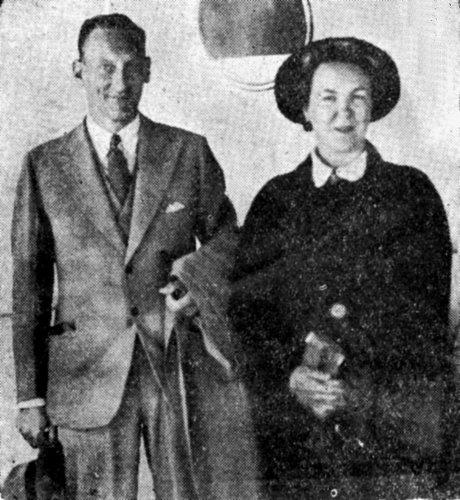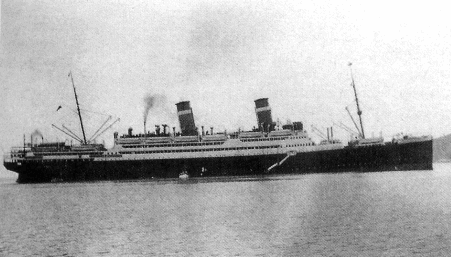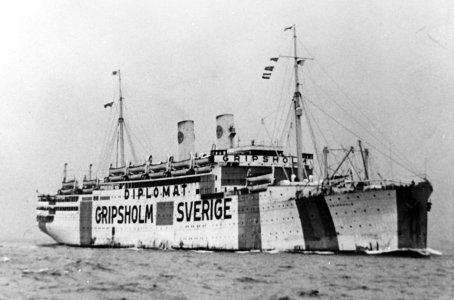Wartime Heritage
ASSOCIATION

The Long Voyage Home - Jack and Kathleen Allan
On June 25, 1942 the Canadian External Affairs
Department in Ottawa announced the twenty-eight names of
Canadian nationals reported to have sailed from Japanese
occupied Hong Kong, and various parts of China, including
Shanghai, for Lourenco Marques, Portuguese West Africa, en
route to Canada. The were expected to reach the North
American continent in early September.
Included on the list were Jack Wilmer Allan and Kathleen
Mary (Mahoney) Allan.
Kathleen was born on May 10, 1901 and grew up in
Yarmouth, Nova Scotia. Jack, the son of Charles Pasedag Allan
was born in Shanghai, China in May 1902.
Charles Allan, Jack’s father, was a stock broker and
accountant and lived in Yarmouth. In 1901 he was living in
Shanghai, working as an accountant. Jack’s mother and father
were married in Shanghai, and the family travelled between
there and Victoria, BC. until Jack’s father died in 1914.
Relatives of the Allan family lived in Yarmouth, NS.
In 1921 Jack began working as a Junior Assistant with the
Shanghai Municipal Council and was serving as a Deputy
Secretary with the Municipal Council as the time of the
Japanese occupation of Shanghai. During his various trips to
Canada he visited relatives in Yarmouth.
Jack, a Deputy Secretary with the Shanghai Municipal Council and Kathleen, a Nurse, were married and living in Shanghai when
Japan declared war on the Allies in December of 1941. Life in Shanghai was precarious from 1931 when Japan first began its incursion
into Chinese territory. In 1937 China began to fully resist Japanese encroachments into her territory and Shanghai came under attack by
the Japanese in that year.
Britain and the US both maintained small naval forces on the Yangtze River in order to protect their interests in China that included
the Shanghai International Settlement, an autonomous district of the city inhabited by Westerners. It was originally protected by British
soldiers, US Marines, Royal Navy and United States Navy gunboats, but most of these had been withdrawn by December 1941. The
Japanese surprise attack on Pearl Harbour on December 7, 1941 was followed by an attack against British and US warships at Shanghai.
The Imperial Japanese Army entered and occupied the British and American controlled parts of the city.
The United States first proposed the repatriation of the Japanese and American diplomats on December 13, 1941. In May 1942,
Japan and the US agreed to exchange interned diplomats and other citizens and three ships were chartered, the Conte Verde, the Asama
Maru and the Gripsholm. This exchange included 28 Canadian diplomats and their families. The Conte Verde and Asama Maru were sent
by Japan, and the Gripsholm by the US. Two exchanges were arranged, the first in 1942 for diplomats and the second in 1943 for
missionaries and businessmen.
On the first exchange, 1,097 Japanese diplomats boarded the Swedish liner Gripsholm in New York and Rio de Janeiro in Brazil
before sailing for Lourenco Marques, Portuguese West Africa, (Mozombique) chosen as the closest neutral territory to Japan where they
were exchanged for Allied diplomats from Japan and occupied
China.
Jack and Kathleen Allan boarded the second exchange ship,
the Conte Verde and travelled from Shanghai with some 600
passengers. Their ship stopped at Singapore where it was joined
by the third exchange ship, the Asama Maru that had sailed from
Yokohama. The two ships arrived at Lourenco Marques, on July
23, 1942. These two vessels carried 1,500 diplomats and their
families from Japan, Shanghai, Hong Kong, and Saigon.
The actual exchange occurred on July 23 in Lourenco
Marque and the Gripsholm sailed for Rio de Janeiro and then to
New Jersey in the United States were the repatriated American
and Canadian citizens were landed.
For Jack and Kathleen Allan the voyage that started in
Shanghai lasted about two months and covered a distance of
some 15,000 miles. It was in Rio de Janeiro, Brazil where Jack
and Kathleen were able to finally send word of their safe arrival
to relatives in Yarmouth, Nova Scotia.
They arrived in Yarmouth in August 1942 and visited with
Jack’s aunts for a vacation after their ordeal. The couple
expressed satisfaction on their safe arrival in Yarmouth after the
somewhat hazardous journey but shared little, except perhaps
with close family, about their experiences during internment and
the voyage. They were very much relieved to get home.
Jack and Kathleen Allan eventually lived in British Columbia. Jack Wilmer Allan died on December 12, 1988, aged 86, in Victoria,
BC. Kathleen Mary (Mahoney) Allan died August 13, 1996, aged 95, in Victoria BC.
Their wartime experience and their story serves as one unique example of Yarmouth’s many world connections during World War II.

copyright © Wartime Heritage Association
Website hosting courtesy of Register.com - a web.com company
The Long Voyage Home
Jack and Kathleen Allan

Jack Wilmer Allan and Kathleen Mary (Mahoney) Allan
August 1942

Conte Verde

Gripsholm



- World War I - Menu
- WWI Stories and Articles
- Photos - Yarmouth Soldiers
- Selection of World War I Songs
- WWI Casualties of Yarmouth, NS
- Those Who Served - Yarmouth, NS
- WWI Casualties Digby Co. NS
- WWI Casualties Shelburne Co. NS
- Merchant Mariners (1915) Yarmouth, NS
- Canadian Forestry Corps - Non Yarmouth Birth/Residence Enlistments
- US Draft Registry - Yarmouth NS Born


- World War II - Menu
- WWII Stories and Articles
- Telegraphist Air Gunners
- WWII Casualties of Nova Scotia
- US Casualties with NS Connection
- Far East/Pacific Casualties with NS Connection
- Merchant Navy Casualties Nova Scotia
- Nova Scotia WWII Casualties Holten Canadian War Cemetery
- D-Day Casualties - Nova Scotia
- CANLOAN Program Casualties - Nova Scotia
- Battle of the Bulge Casualties - Nova Scotia
- WWII Casualties Yarmouth NS
- Yarmouth Casualties - RCAF RAF Canadian Army WWII
- Yarmouth Co., Marrages WWII
- Casualties Non-Born/Residents with Connection to Yarmouth Co., Nova Scotia.
- WWII Casualties Digby Co., NS
- Non-Nova Scotian WWII Casualties Buried in Nova Scotia
- WWII RCAF Casualties Aged 16-18
- Brothers/Sisters Who Served - World War II













